Great Depression & World War II
Contemporary Events
- During “the Great Depression” unemployment is extremely widespread. Agriculture (who were already struggling) suffers further in the aftermath of a series of disastrous natural events (floods and dust storms). The mid-west was hardest hit, giving this region the nickname “Dust Bowl”.
- Not everyone was poor. The upper class was extremely rich. The divide between rich and poor was vast, with very few individuals falling in between.
- In Europe, Germany and Italy planted their roots in Fascism. Adolf Hitler rose to power in Germany in 1933. Italy invades Ethiopia in 1935. 1936: Italy and Germany from the Rome-Berlin Axis. 1938: Germany annexed Austria and part of Czechoslovakia. September 1, 1939: Germany’s invades Poland. This event marks the onset of World War II.
- December 7, 1941: Japan attacks Pearl Harbor drawing the United States into the war. Wartime manufacturing was incredibly profitable for the US and provided economic recovery from the “Great Depression”.
- Silent films were replaced with talking pictures by the 1930s.
1930s-Women (~1930-1939)
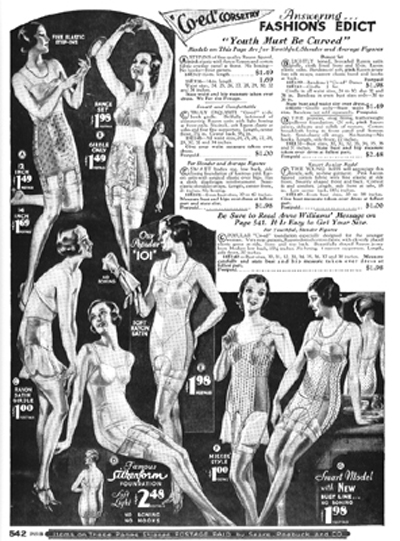
Page from a Sears Catalogue. (Everyday Fashions of the 1930s as pictured in Sears Catalogues)
The boyish flapper figure of the 1920s “grows up” to become a silhouette of very feminine natural curves in the 1930s. The waist line returns to correspond with the natural waist and by utilizing bias cutting techniques garments hugged a woman’s curves while remaining soft and comfortable.
The available undergarments serve to support and smooth the figure rather than transform it into an unnatural shape. Brassieres begin to more closely resemble those of modern women–cut with the intention of lifting, supporting, and emphasizing the natural shape of the bustline.
Corsets or “girdles” are worn primarily by larger women. Shaping is acheived through elasticized fabric panels and light boning. They smoothed out problem areas of the figure rather than attempted to compress it into a new shape. Smaller girls may wear them, too, if they so desired. However, it was acceptable to go without.
Panty briefs or “briefs” grow shorter to fit under clothing actually worn for sports (called ACTIVE Sportswear). They soon find favor for all occasions, and become the norm as far as panties are concerned. Older women still favor fuller, looser “bloomers” or “knicker” styles cut along the lines of what we would call “tap pants” in the costuming world.
Inexpensive underwear was made of cotton, rayon, or even acetate. Expensive underwear is made of silk.
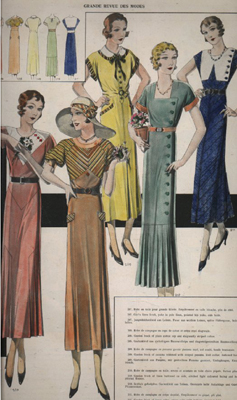
French fashions c. 1933.
When the stock market feel in 1929, so did the hemlines–settling at about the low calf. In the memory of costume history, this sudden change feels nearly immediate–as if it happened over night. When the hems drop, the waist rises. The boyish figure of the 1920s is gone. The new silhouette clearly defines bosom, waistline and hips through the cut and cling of the garment.
The 1930s is an era marked by great emphasis on the cut (rather than the decoration) of the garment. Much of the fashionable details are achieved through creative cutting and interesting seam lines. Fabric patterns were often manipulated in order to acheive interesting effects (as in the brown dress at the right). In addition to this sometimes the decoration takes on a sort of assymmetricality–notice the button closures running down the (model’s) left side of the green dress at the right. The geometric influence of the trends of Art Deco are strongly felt in the cut of these garments.
Just about every style of neckline was available–including jewel, “V”, Cowl, and collars. In fact, common decorative details include a medium to large sized collar or other soft neckline finishes such as bows or jabots (ruffles).
Skirts were usually cut utilizing the principle of gores. However, again, the seamlines are manipulated to create interesting decorative effects and to take advantage of bias stretch. Often bias cut pieces are specially set into a yoke that covered the hips in order to create a narrow, but flaring skirt.
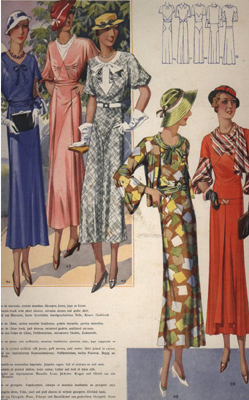
French fashion. c. 1933
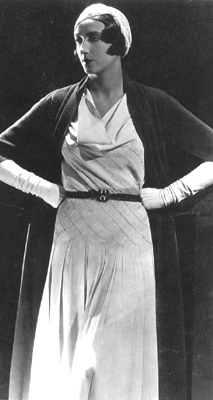
Madeline Vionnet daywear ensemble
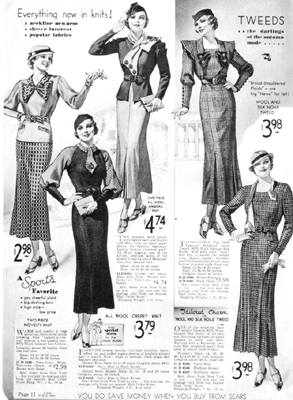
Page from the Fall 1933 Sears Catalogue. Republished in Everyday Fashions of the 1930s as Published in Sears Catalogues.

French Fashions made available in a home sewing pattern, 1932
Blouse/skirt combinations and suits remain staple items in a lady’s wardrobe. They were made of firmer, more stable fabrics. The line–especially among the “tailored’ items such as suits–is not supple like the dresses worn for day or evening wear. Many of the styles were clearly modeled after men’s suits, though the shapes are adapted in order to accomodate the curves of the female body.
We also see a trend for using suit fabrics in day wear for non-suit looks. Both knit and tweed fabrics were created and utilized in this manner.
During the middle of the decade the shoulder line of the torso begins to widen. Championed by Hollywood costume designer Adrian for costumes worn by Joan Crawford, the “padded” shoulder look becomes a common trend of the 1940s.
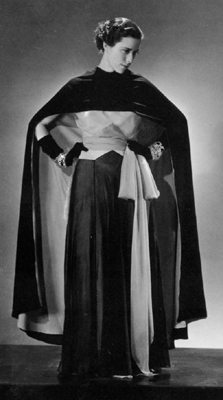
Madeline Vionnet evening ensemble
Evening gowns of the 1930s again reach the floor. As in daywear, the bias cut dominates most styles. The silhouette of these dresses generally hugged a woman’s curves to the hips and then flared out to a wide hem. They commonly had a sensual quality to them with deep plunging backs and/or halter style necklines making it a bit impossible to wear a bra. A young lady with a naturally achieved fashionable figure could go without. Sleeveless styles were possible, as were full, puffed or capelike sleeves. Again, assymmetrical Art Deco-inspired details are the trend. These dresses are the definition of elegance.
Towards the end of the decade, everything simplifies. Construction details decrease and ornamentation becomes even less. Overall the lines become more severe. Some evening styles even feature blouse and skirt combinations or evening suits with long skirts and matching jackets of plain, uncluttered lines. These were often paired with soft, frilly, and sometimes backless or sleeveless blouses.
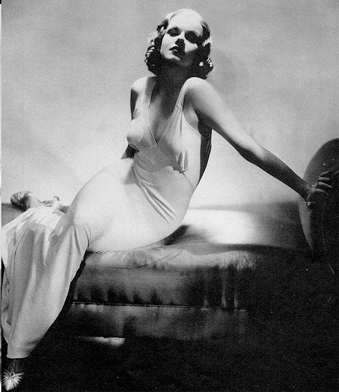
Jean Harlow ‘Dinner at Eight’ -Dress designed by Adrian, 1933
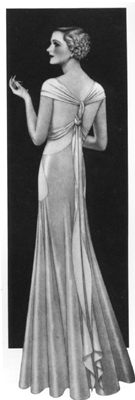
Fashion Sketch of a Vionnet gown
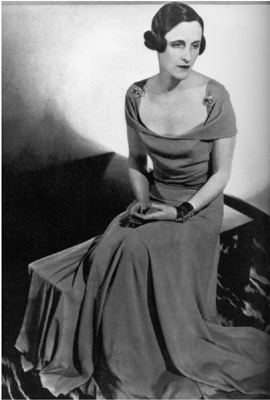
photograph of Sophie Gimbel (AKA “Sophie of Saks”) wearing a coral crepe Vionnet dress, 1933. Sophie was married to Adam Gimbel, owner of the department store Saks Fifth Avenue, NY
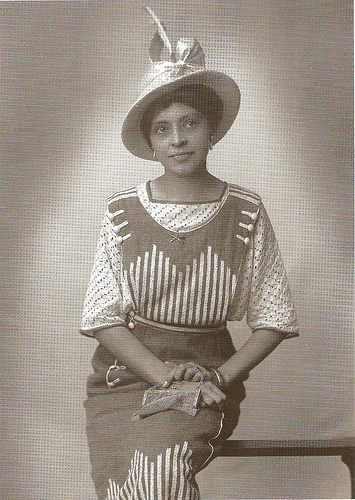
photograph, 1930s
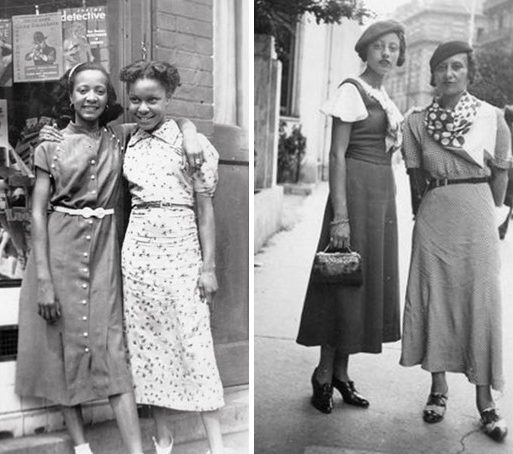
2 photographs of girls and ladies in daywear, 1930s
WWII-Women (~1940-1947)

Women of steel working during wartime, November 27, 1942. Sheffield, UK
During the second World War most of the fighting took place overseas, not on American Soil. In fact, the United States pretty much stayed out of the war until the attack on Pearl Harbor in December of 1941. However, the American economy became increasingly involved with manufacturingl supplies for the war efforts. In fact, it was wartime industrial production that historians credit with bringing the U.S. out of the Depression.
The need for supplies to support the war resulted in the rationing of food and consumables. L-85 REGULATIONS restricted the quantity of cloth that could be used for clothing. Trouser cuffs, extra pockets, vests with most suits were eliminated from fashion in order to conserve fabric. These restrictions also regulated lady’s skirt hem widths, as well as the length of men’s trousers and suit jackets. (Some garments did remain exempt from restrictions, however. Wedding gowns and burial clothing escaped due to the sacredness of the rituals associated with such garments.)
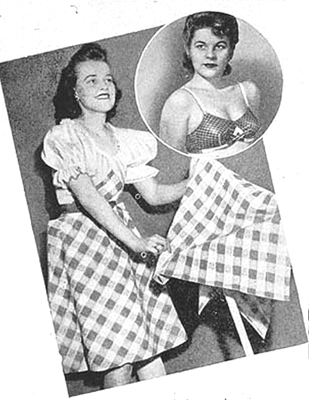
A tablecloth repurposed to create bras. “She Saves Who Sews for Victory” Home Sewing on the American Front.
Most of the L-85 Regulations address fabrics that were available before the war and now were in short supply. Nylon (introduced in 1939 @ NY World’s Fair) was completely diverted away from civilian use and was used heavily for the making of military equipment such as parachutes. Wool also became quite scarce and silk supplies (which came mostly from lands lying in the East) were cut off altogether. Natural rubber and leather were also unavailable for civilian use.
Civilians had to get fairly creative in order to continue to stay fashionable. Their innovations included:
–“Make Do” campaigns encouraging women to sew old clothes into new. Men’s suits were often re-cut into women’s with tailoring details and shoulder padding remaining intact. Soon shoulder pads can be found in most women’s garments, not just suits.
–Leg makeup (with seams drawn up the back of the leg) was used to resemble nylon stockings.
–Wood & cork was employed to sole platform shoes.
–Ladies turned tableclothes into bassieres; old blankets into coats.
–Pillow cases were made into blouses
–Wedding dresses were worn by multiple brides and then turned into underwear or nightgowns when they started to wear out.
–Milk top disks were covered in raffia and made into handbags or other accessories.
Unrationed fashions–especially hats and hairstyles– become more elaborate and more complex.
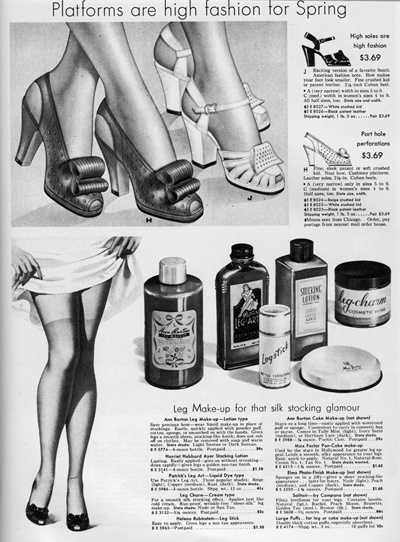
An advertisement for leg make-up and platform shoes found in the Sears Catalogue (republished in Everyday Fashions of the 1940s)
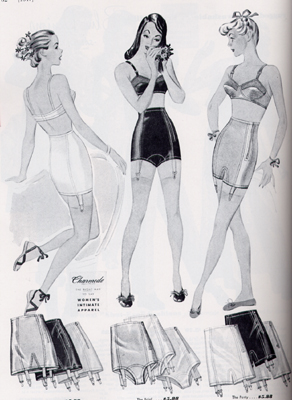
Typical undergarments of the 1940s
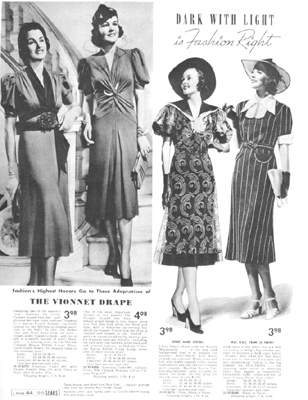
A catalogue advertisement for ladies daywear
Due to the effects of rationing and the scarcity of supplies generally used for the manufacture of clothing, styles of the late 1930s and early 1940s seem suddenly frozen in time. Despite this, women’s clothing continues to evolve. Between 1940 and 1947 these “frozen” styles simplify and become more utiliatarian and somewhat masculine.
The most notable silhouette distinctions during the second World War include:
–Skirts just below the knee with moderate hem widths.
–Broad padded shoulders.
–Fewer construction details and even less ornamentation than before.
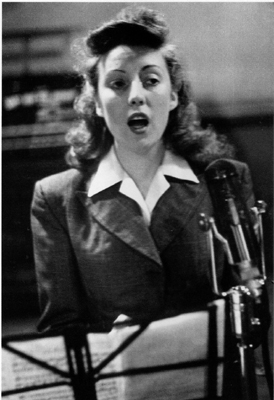
Since hair was one of the few things that couldn’t be rationed during the 1940s, a woman’s hairstyle became the center of a fashionable appearance. The shorter styles of the 1920s and early 1930s were once again allowed to grow. Cuts and styling became much more complex. The page boy bob–as popularized by June Allyson–was a straight shoulder length hairstyle worn with the ends curled under. The upsweep (dressing hair on top of the head in curls or braids) was also popular.
Working women would cover their hair with turbans or snoods(hairnets that hung off the back of the head) to protect their hair from getting caught in the machinery.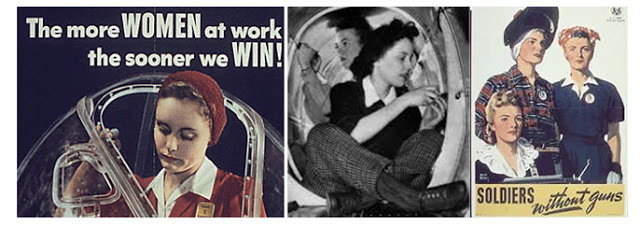
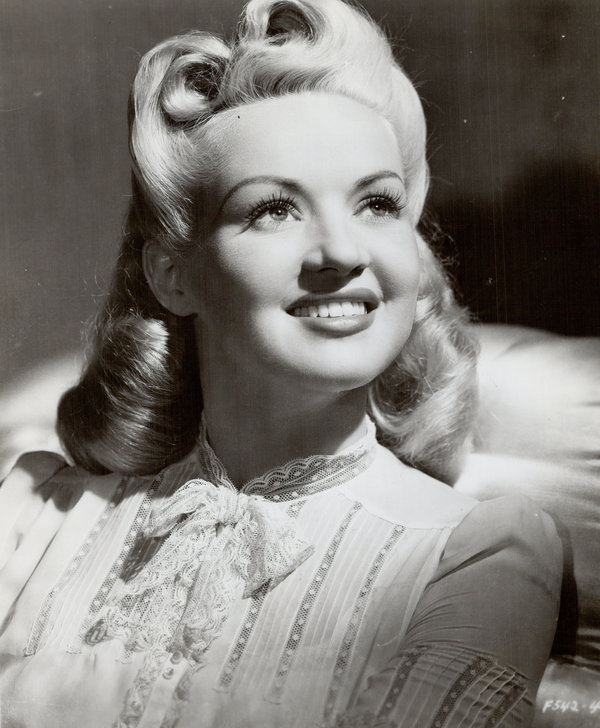
CANADA – MARCH 01: Betty Grable (Photo by Toronto Star Archives/Toronto Star via Getty Images)
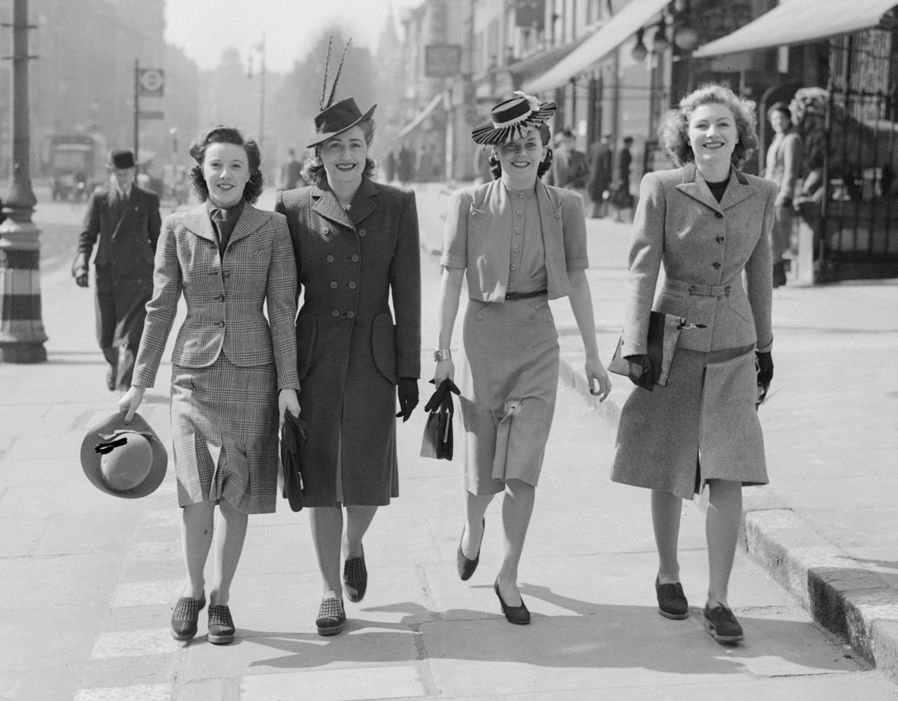
Four women photographed on a London street wearing 1940s wartime clothing
Recent Comments